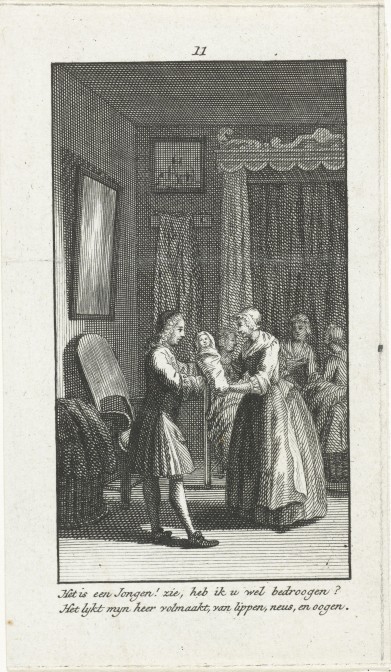A vroedvrouw was a midwife. There were also vroedmeesters, doctors specialized in helping women deliver children.
The midwife was responsible for more than just seeing the mother and the child safely through the birth. In the case of an unwed mother, she was also urged to press the mother into revealing the name of the father of her child. It was believed that no woman would lie in childbirth. She would know that she could meet her maker at any minute and would have to account for her sins. If a woman named a man as the father of her child while giving birth, this carried great weight in a paternity suit or with the church authorities. The man could be censored and possibly required to pay child support, compensation for ‘defloration’ of the mother and the cost of the labor, or marry the mother.
As a person who was present at the birth, the midwife was also one of the persons who could report about the birth of a child after the introduction of the civil registration in 1811. When you see a midwife as the informant of a birth record, you should check to see if a father was mentioned. Just because a midwife registered the birth, doesn’t mean that the child was illegitimate. The father could also have been ill, or away on business or in prison.

Newborn baby presented to his father. Credits: Rijksmuseum


We have traced my husband’s family to Barent van Nijmwegan From Provgeldersland. We have no dates or other information. He was born before 1680. He had a son Hermanus born in the same are @1680. Where would I go to look for information and possibly further lineage? thank you, Eleanor
“Provgeldersland” sounds like a misspelling of the province of Gelderland. Van Nijmwegen could be a last name or denote a place of origin (from Nijmegen). Gelderland records are available at the website of the Gelders Archief, http://www.geldersarchief.nl, but that website is available in Dutch only. But if you only have a name, that will usually not be enough to identify the person in Dutch records. You may find several people by that name but without more information, you won’t be able to tell if you’ve got the right one. Please see my article about finding your immigrant ancestor in the Netherlands for more information.
The American Van Inwegen family descend solely from Harmanus Barents van Nijmegen. He married the widowed daughter in law of Roeloff Swartwout, Schoutt of Esopus. We know nothing of his father Barents – just his patronimic. Harmanus was brought in the Wagheckemeck Patent [aka Peenpack] in Mamakating Precinct, Ulster County NY to protect the interests of his Swartwout stepsons. Harmanus was given a section of his own in exchange for protection. This area that was later [1798] became part 8f the Town of Deerpark Orange County, NY We do know he married at Kingston Ulster County NY & renounced his Roman Catholic faith at the DRC of Magheckemeck in the last years of his life. We believe he’s buried at the old burialground now known as Gumaer Cemetery- where we found a stone with what appears to be his “signature mark.” I am 6Gr Granddaughter of Harman Barentsen Van Nijmegen & Jannetje Jacobse.